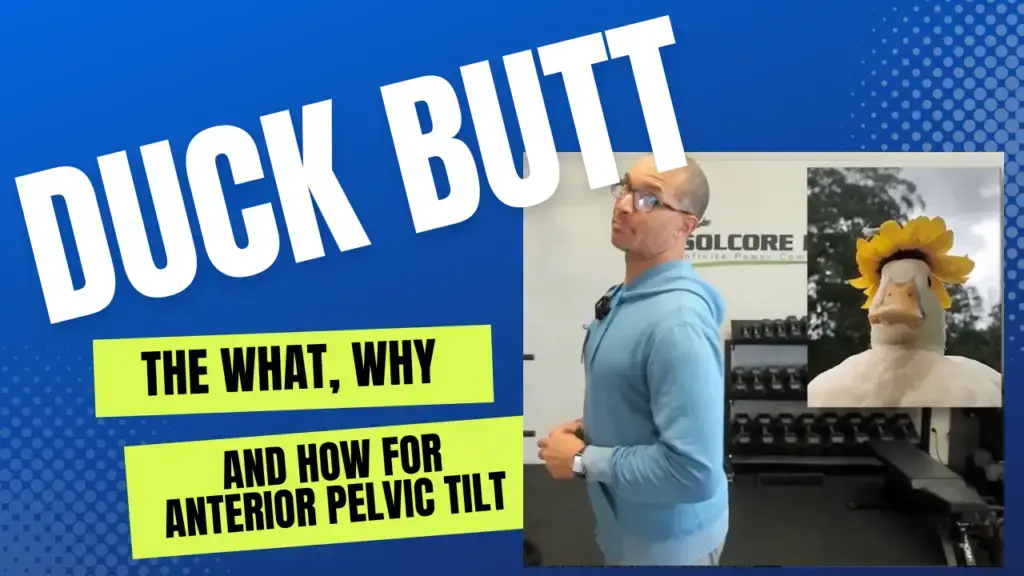Anterior pelvic tilt, or duck butt, is a postural problem that can lead to a lot of physiological issues, especially in your lower back. Anterior pelvic tilt disorders require understanding why you have the anterior pelvic tilt and corrective exercises for anterior pelvic tilt. Tune in to find out both.

Click on the image to watch
Anterior pelvic tilt, otherwise known as duck butt. Now as funny as that may be, the anterior pelvic tilt is actually not funny. It’s a pathological posture problem that can lead to a lot of issues. So if you’re interested in finding out more or you have an anterior pelvic tilt, they want to see what can happen with one and how to get out of one. Then stay tuned. How you doing? I’m Ekemba Sooh. I’m a Soma therapist and a Soma trainer, and I’ve been in this field for almost 30 years and I had an interior pelvic tilt and it was one of the main causes as to why I got an L 4 L 5 disc bulge and sciatic pain on my left side. But nowhere along the process with the trainers and athletic trainers before the injury or the doctors and therapists after the injury, did anybody bring up that?
That’s the reason why I had it. That’s because all these people are symptom-based professions. They want to cure a symptom, not the cause. The cause. One of the causes was the anterior pilic tilt. I was even taught to squat by sticking my butt out and looking up to keep myself nice and tall. I was taught that it’s totally stupid. So I want to talk about this topic and more in a holistic fashion because it’s not just about the symptom or the one little goal you have, it’s about holistic the cause. What contributes to all the things that you want to accomplish in your life. So if you want to hear more, subscribe, if you’d like the video, give me a thumbs up and share with your friends. An anterior pelvic tilt is when your pelvis tilts forward more than normal and stays there. So your pelvis is naturally tilts forward, kind of dally forward and down.
Normally an anterior pillow tilt is if it gets pulled too far forward and can’t pull back, back to normal. The most stable position we have for our pelvis is quaded hands and knees on all fours. But since we have to be biped walk around our feet that a pelvis is always going to be in that slightly tilted forward position and even without an anterior pivot tilt, the forces for my body ascending, descending and intrinsic forces accumulate more down toward the lower back top of the pelvis. It isn’t bad if everything’s in place doing a job. It’s bad if it becomes pathological like an anterior pelvic tilt. Our body was designed to allow forces to attenuate, to disperse as we move around in life. So when we’re walking, taking steps or reaching over to grab something or the forces from gravity come down to us where somebody bumps into us, those forces that happen whenever we do things should move through our body in a pretty fluid way.
It’s called tensegerity. Tensegerity is by Buckminster Fuller who is an architect. And then a bunch of really smart people saw that tensegerity was also the body and they said, okay, this is biotensegerity. So that’s what we are. So that allows us to disperse the forces properly. You can see here in this shot that tensegeruity has a bunch of wonderful things that it can accomplish. It’s very effective structure to use, not in our body but also in architecture. But the main one I want to talk about here, which applies to this video is that the load produced on the structure is distributed throughout the structure. A tensegerity structure. Our body will continue to function even if part of this structure becomes compromised. So I can have one little part of my soft tissue become tight, weak, or stupid, and my body will continue to move.
It’s called compensation at the beginning. Compensation’s not a bad thing. It allows our whole body to continue to move. When one part’s not taken away, we we’re not a Christmas tree light. We don’t take one out and all thing shuts down. We can still move. So that’s great, but it’s not great because you continue to move so you think, eh, nothing’s wrong, but it is right. And now over time that compensation accumulates then activates another area to go down, then another area, then another area you’ll keep moving, but eventually the accumulation of compensations will become pathological and permanent. Let’s take a beat here so you can digest all the information I gave you and check in. Do you have anterior perfect tilt and if so, what are you doing for it? Just let me know in the comments. Now I want you to stay tuned because if you’re not doing anything for it, I want to let you know what could possibly happen and then let you know what you could do to get yourself out.
An anterior pelvic tilt in general is caused when the muscles in front of the pelvis, the cell as and all its hip flexor friends pull the hips, the ileum too far forward in conjunction the muscles in the back, the glute max, your back muscles, your hamstrings are either too weak or too tight or combination two that caused your pelvis to move forward. It’s generally caused, it’s generally a progressive thing, excuse me, and it’s caused by sitting down too much and not doing anything about it and a bad structure and gravity line, meaning you can’t hold yourself in place in your four degree cone. And generally if you lead too far forward it starts to cause that. But there’s also a genetic component. Some people are born with their butt sticking out more just in general. Well now for you it is not going to be a slow progressive thing.
It’s going to go quicker because you’re already going in that direction just from birth. You have like a genetic thing. So you have to have more intention placed to not go really pathological. So if you end up in this anterior, if it tilt whether they’re fast or slow, you can put yourself in a bad position. So now those forces I talked that should go through your body attenuate. Nice thing. They start to accumulate more at that area, namely the lower back and SI joint and pelvic area and hip area. They start to go there and they start to produce more force and stay, which means you lead to a bunch of bad things. I’ll give an example. So if I have that interior pelvic tilt and my pelvis is tilting forward while on the top of my pelvis connected to my sacrum, which is part of the pelvis is L5.
L5 stands for lumbar fifth. The lumbar is your part of your spine. So I’ve taken that part of my spine and it goes forward. Now, when it goes forward more, right, it’s going forward more than normal. That means it’s out of place. But because L 4 is above it, then L3, then L 2 and L1, they also go with it. But then because your body doesn’t want to fall down, they overcorrect themselves by coming backwards. Now you have lordosis. So lordotic curve means you have a good lower back. Lordosis means it’s a pathology. Now you have, well now you should have had a bunch of nice spaces between your joints. Now you don’t. They should have been sitting on each other a certain direction, but now they’re not. That’s going to leave the door open for stuff like a disc bulge, a herniation, a prolapse, some arthritis at the joint or in your facet joints, stenosis, what else?
Fun things. More fun things relate to your spine because you have an anterior pelvic tilt and because you’ve taught your body to do that, because you’re either teaching yourself consciously or subconscious or unconsciously, you’ve taught it unconsciously to be that position, it’s still learned to stay there. Now all those tendons, ligaments, muscles, they’ve been taught to do bad things. So now they’re having bad education and they’re going to keep doing that bad education unless you retrain it to do something different. It’s imperative that you train the muscles and the tendons and ligaments. It’s imperative that you tell ’em to do something different because the structure of our body dictates how well you function. Function obviously means how well you move around in space, but it also mean a lot more. So with this anterior pivot tilt, you can also end up with hip problems. You can end up with visceral problems in your pelvis. You can have problems having intercourse, voiding your system, a bunch of urethra type stuff. All that is within your pelvis. And if I put my pelvis out of place, who knows what’s going to happen. It depends on your weakest link. Probably better idea not to wait to see what happens if it’s out of place. Probably better to start training that system to go away. So what do you do? Well, keep it basic. If
Those in the front of the pelvis are too tight, you stretch ’em. If the muscles in the back are too weak and too tight, you strengthen and stretch ’em. But you don’t just do it with the muscle. Your body doesn’t work as a collection of muscles just operating independently. They operate together via the fascia that connects all of our body. So we train something. So let’s say I want to stretch my SOAs. I want to stretch my SOAs because it’s part of my hip flexor complex that also attaches to leg into my spine. Very important muscle. I’m going to have a video on it. I think last week I did very important muscle. So I’m going to stretch that SOAs. I’m going to stretch it to elongate it, but I also want to stretch it with all the fascia connections. If I just work in that muscle and I don’t work in the fascia, it might feel good, but then the next day your body goes back to the same position.
It was because you haven’t trained the fascia, which is part of the intelligent part of the body to do something different. So you have to stretch the SOAs and all the hip flexors and maybe even strengthen ’em. Maybe they’re weak. You have to strengthen fascially those back posterior muscles and then stretch those back muscles. Fascially. It’s impaired that you do this in a holistic manner. If your body functions as one, you need to train it as one. The best techniques I’ve found so far are osteopathic etiology exercises, right? So they take the segmental muscle, say the SOAs, they go, okay, I’m going to train or stretch the SOAs. But they also think, okay, it’s attached these things. So there’s a posture for each position to make sure that it’s working. The muscle and the chain by far so far in my 30 years the best.
So if you are in your twenties or thirties, I implore you to start something like this. Now, I wish I had done this back in the day. I had to wait until I got hurt, until I found something like this. Had I done this back in the day, like I hope you do. And I continued to function at my highest level while preventing myself from getting injuries. You see, when you do this type of program, you keep your structure in place, which means you prevent injuries, but you also increase productivity, which means you can work harder, you can lift more, run faster, do jumpy jacks, whatever, flips more. It doesn’t matter what you want to do, ski better. You can do it better and more effectively because it’s structure. Your body is more aware, it’s more balanced, it’s stronger, it’s more flexible. Everything’s working as one’s very, very effective. If you haven’t done this in your forties, fifties, maybe sixties, even seventies, and you have a pathology and anterior pivotal tilt in this case, then this needs to be your main program because until you bring that back into place, you’re compromising your body because we’re only as strong as our weakest link and relative to this
Video, the anterior pelvic tilt is the weakest link and whatever happens from that. So exercise is the number one way to do this. Not general exercise, not going to whatever, whatever. And just doing basic squats and pull-ups and pushups and or yoga and Pilates is specific exercises that can be used in conjunction with whatever program you want. So the best exercise I’ve found, like I said, are osteopathic type exercises. If you want to learn more, then I’d be happy to help. You can join my private Facebook group. You just click on the link in description, answer some information, agree to the rules and you’re in. And now even an interactive way to interact with me to ask questions, to see my little mini trainings, masterclasses, my big trainings where you participate with me in theory and also in exercises. Great way to do that or I have a free ebook is how to Get out of Paying, get Mobile and Live the Life of Your Dreams.
There’s four steps to that. Again, in description, just click on it, put in your information, you get instant access, or you can reach out to me personally by using the description. I always do that by using the link in the description that goes to my calendar link. You can choose a time that works for you and we can talk. So I hope this is helpful. Again, if you like this, please give it a thumbs up. It tells YouTube that it’s good and lets other people see it, and then also share it. And don’t forget to subscribe. Take care.

MOVE BETTER, REDUCE PAIN, AND LIVE LIFE ON YOUR TERMS
it’s not just working out, it’s building a foundation for a better life.
Find out more @



Leave a Reply